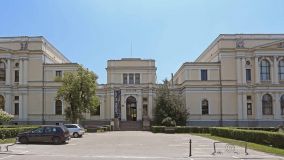This priceless masterpiece of medieval Judaica most likely originated in 14th century Spain and may have been made as a wedding present, celebrating the union of two families whose coats of arms appear in the bottom corners of the book.
It is known that the Haggadah left Spain after the expulsion of Jews in 1492, that it traveled throughout Europe and it most likely arrived in Sarajevo with Jews who had found refuge here during the 16th century.
The National Museum of Bosnia and Herzegovina acquired the book in 1894, after which it was sent to Vienna for authentication, and then it miraculously returned to Sarajevo a few years later. After this point, the story of the Haggadah becomes as intricate as the story of Sarajevo itself, and it has become a symbol of the survival and perseverance of the city.
Until 2002, when a permanent exhibit hall was opened to display the Haggadah, the book was kept deep in the manuscript section of the National Museum of Bosnia and Herzegovina and was only seen by those lucky enough to have special access, and yet, everyone was aware of the book’s existence.
In 1941, when the Nazis occupied Sarajevo, one of the first objects they sought out was the Sarajevo Haggadah. However, thanks to the wit and ingenuity of the director of the National Museum, Jozo Petrović, and the museum’s curator, Mr. Derviš Korkut, the Haggadah was kept out of the Nazis' reach.
It is unclear what happened to the Haggadah during World War II but there are several legends that surround its safekeeping. One account says that the director of the museum took the book to a mosque in a village up on Mount Bjelašnica, where the imam hid it beneath the threshold of the mosque. Another legend claims that it lay buried beneath a tree for the duration of the war.
According to Sarajevo's Jewish Humanitarian Society, La Benevolencija, the book was, most likely, tucked away on a hidden bookshelf in the library at the National Museum. Whatever may have happened, the book resurfaced at the National Museum of Bosnia and Herzegovina in 1945.
The Sarajevo Haggadah was kept in the museum until 1992, when the institution, along with the entire city, came under siege. Unlike other valuable manuscripts and museum pieces that went up in the flames of war, the Haggadah was rescued by the brave museum director, Dr. Enver Imamović, as well as several police officers and members of the local defense unit.
The book was then transferred to the vault of the National Bank of Bosnia and Herzegovina, where it waited for better days to come.
While the war in Sarajevo raged on, there were speculations that the government of Bosnia and Herzegovina had sold the book to buy arms and that the book had been destroyed.
In 1995, U.S. Senator Joe Lieberman (from Connecticut) challenged the Bosnian government by declaring that he would come to Sarajevo for Passover if the Sarajevo Haggadah would be placed on the table. The President of Bosnia and Herzegovina, Alija Izetbegović, and Prime Minister Haris Silajdžić accepted the challenge and brought the book to the Jewish Community building for Passover. The event was broadcast all over the world, but Senator Lieberman was unable to arrive due to security reasons.
It seems that now, six centuries after leaving its home in Spain, it has finally found a place of its own.


